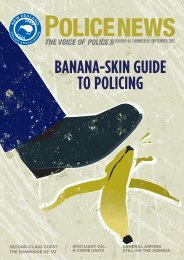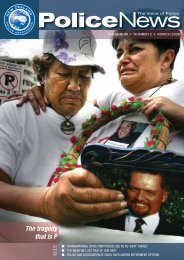Police News May - New Zealand Police Association
Police News May - New Zealand Police Association
Police News May - New Zealand Police Association
You also want an ePaper? Increase the reach of your titles
YUMPU automatically turns print PDFs into web optimized ePapers that Google loves.
<strong>New</strong> <strong>Zealand</strong> <strong>Police</strong> <strong>Association</strong><strong>May</strong> 2004Letters to the Editor Write it here! Letters to the Editor are welcome.Signed letters are preferred, but in all cases the writer’s name and address must be supplied. Names willbe published unless there is a good reason for anonymity. The editor reserves the right to edit, abridge ordecline letters without explanation. Write to: editor@policeassn.org.nz or post it to the Editor atPO Box 12344, Wellington. Letters under 350 words are preferred.Judge responds toyouth justice featureI welcome any focus on youth justice(<strong>Police</strong> <strong><strong>New</strong>s</strong>, January-February), but alsobelieve the subject could have been givenmore balanced and informed treatment inyour special feature.You quote police officers as saying: “Theyouth justice system is in disarray”.(Which police officers? Your specialfeature did not include comment fromeither Inspector Chris Graveson, theHead of <strong>Police</strong> Youth Aid, who is vastlyexperienced, nor from SuperintendentSteve Christian, the Head of <strong>Police</strong>Services, who later issued a correctivepress statement in response to yourarticle.) I cannot accept your claim madeabove reflects the true position. Considerthe following statistics:• Youth offending has remained a stable22% of total offending over the last 10years.• The apprehension rate for 14 to16-year-olds increased significantly in thefirst part of the last decade but hasremained relatively unchanged since.So too, the apprehension rate for 10 to13-year-olds.• Only a small percentage of offendingby under-17-year-olds is “serious”offending.• Violent offending by under-17-yearoldshas remained relatively stable inthe last five years. (It may be that thedegree of violence is becoming morepronounced and is being committedat a younger age - we simply have nostatistics on that important point.)• The number of charges processed inthe Youth Court has remained relativelyconstant in the last five years anddecreased slightly in the last two years.The number of offenders in the YouthCourt has been stable in recent years.Whatever conclusions we might chooseto draw from those statistics, they wouldnot be that the youth justice system is indisarray. Youth offending is certainly noworse than patterns of overall offending,and following the increases in the earlierpart of the 1990s (when offending almostdoubled) youth offending rates havestabilised in the last eight years.Some of the other claims in the specialfeature are way off the mark. For instance,the youth justice system is described“as a system which treats victims asmere bystanders.” Not true. Under theprovisions of the legislation, victims mustbe specially acknowledged and consideredin all decision making. Victims are invitedto Family Group Conferences (FGCs) andfrequently play a pivotal role. At FGC’s,<strong>Police</strong> provide support to victims andassist in making sure their perspective isunderstood.<strong>New</strong> <strong>Zealand</strong>’s youth justice systemis hailed internationally as givingunparalleled recognition to the rights ofvictims. Victims are more involved in thehearing of youth offending issues thanin any other part of the <strong>New</strong> <strong>Zealand</strong>criminal justice system. That there areinstances when the system miscarries atthe victim’s expense can hardly make theargument that the system reduces victimsto the role of bystanders.Many of the deficiencies in the youthjustice system that are identified in yourarticle are now well rehearsed. Thereis no disagreement with many of theobservations made by Sergeant Roper.- There is an ongoing crisis ofunavailability of residential beds for youngoffenders, and the level of police cellremands is unacceptable.- The supervision with residence sentence,the most serious that can be imposed bythe Youth Court, needs to be longer, andmust be better managed and practised.- The monitoring of FGC plans issometimes inadequate and patchy.Consequently, cases take too long tofinalise.(These and other criticisms were clearlyidentified by the Ministerial Taskforce onYouth Offending. It is concerning theyhave not been resolved.)It is also quite correct to identify asmall group of offenders who have adisproportionate effect on the youthjustice system. This group generally sharesthe following common characteristics:• 70-80% have a drug and/or alcoholaddiction.• 70% are not at school - many are noteven enrolled at a secondary school.• Most experience family dysfunction,with a lack of a positive male rolemodel.• Most have a borderline psychologicalor psychiatric problem, and displaylittle remorse, let alone victim empathy.• At least 50% are Maori and in someYouth Courts the Maori appearancerate is 90%.• Many have an institutional background(care and protection).This small group of young offenders isproblematic for every Western country,and presents a challenge for any youthjustice system. They represent 5-15%of young offenders but commit 55-70%of all offences. But it is quite wrong tosuggest these young offenders are not heldto account.It does your article no credit to refer tounnamed <strong>Police</strong> officers who criticise “softjudges” or “judges who differ widely inthe manner in which they treat the sameoffences”. In fact the majority of decisionsabout young offenders are made at anFGC and are unanimous. <strong>Police</strong> are alwaysrepresented at such conferences. Judgescan hardly be criticised for accepting theunanimous recommendations of FGC’sin which <strong>Police</strong> have participated. Wherethe offending is much more serious, thereis a provision to impose “top end “YouthCourt sentences or to convict youngoffenders and transfer them to the DistrictCourt. There are clear statutory guidelinesfor the imposition of these sentences.If the <strong>Police</strong> believe Judges have madewrong or inappropriate decisions then theavenue of appeal is always open and, inthe interests of the community, should bepursued to correct any perceived injustice.The example given of a computer for anoffender who apparently failed to liveup to the agreement of her FGC is veryconcerning. If the <strong>Police</strong> were aware ofthis case, it should have been brought tothe Court’s attention so that it was clearthere was a breach of the offender’s FGCPlan. If a formal order had been made anapplication for review could have beenfiled.It is important that the valuable work ofthe <strong>Police</strong> Youth Aid division is properlyappreciated. <strong>Police</strong> Youth Aid providescreative diversion programmes whichhold young people to account but assistthem not to re-offend. About 80% of allyouth offending is dealt with this way.While the <strong>Police</strong> may be doing the bestthey can with the resources they have,the argument can be made that <strong>Police</strong>Youth Aid needs more resources. Thereare insufficient officers. There is a lack ofa clearly defined career structure. Thereare insufficient senior Youth Aid officers.Supervision for new officers is sometimes85
















